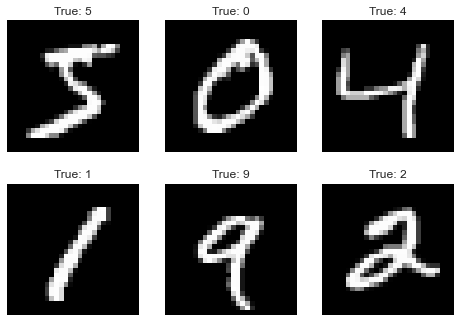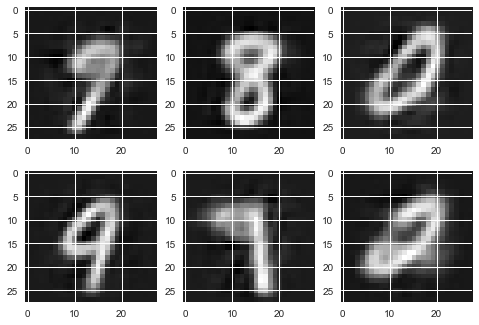机器学习算法-VAE
- 机器学习算法-VAE
- 1. VAE模型推导
- 1.1 算法引入
- 1.2 模型推导
- 1.3 损失函数
- 1.4 重参数技巧
- 2. 实现
- 2.1 模型定义
- 2.2 实验
- 1. VAE模型推导
1. VAE模型推导
1.1 算法引入
在EM算法中,隐变量的最优分布\(q^{\star}(\mathbf{z})\)是在观测数据给定时的条件分布\(p(\mathbf{z}|\mathbf{x})\),此时对应的证据下界与似然函数相等。但是在实际中,后验概率可能很难计算甚至不能计算,这时EM算法中的E-step便无法进行。VAE的思路是用一个新的分布\(q(\mathbf{z}|\mathbf{x})\)进行估计:
1.2 模型推导
将KL散度的计算公式进行变形得到:
通过对KL散度的改写,我们找到了似然函数的一个下界,对这个下界优化可以近似得到似然函数的最优值。为了优化变分下界\(\mathcal{L}_{\mathrm{ELBO}}\),将其形式进行变换:
变分下界中出现了三个概率分布,为了方便求解,并对分布的类型和参数做了假设:
-
\(q(\mathbf{z}|\mathbf{x})\):编码器,根据样本\(\mathbf{x}\)生成对应的隐变量\(\mathbf{z}\)
\[q(\mathbf{z}|\mathbf{x})=\mathcal{N}(\mu_1, \sigma_1^2)\\ [\mu_1, \log\sigma_1^2] = f_{\theta}(\mathbf{x}) \] -
\(p(\mathbf{x}|\mathbf{z})\):解码器,根据隐变量\(\mathbf{z}\)生成样本\(\mathbf{x}\)
\[p(\mathbf{x}|\mathbf{z})=\mathcal{N}(\mu_2, \mathbf{I})\\ \mu_2 = g_{\phi}(\mathbf{z}) \] -
\(p(\mathbf{z})\):隐变量的先验分布
\[p(\mathbf{z})=\mathcal{N}(\mathbf{0}, \mathbf{I}) \]
其中\(f_{\theta}(\cdot)\)和\(g_{\phi}(\cdot)\)分别是参数为\(\theta\)和\(\phi\)的神经网络。
1.3 损失函数
在变分下界中存在两项:重构误差和KL散度项。重构误差实现了让解码出来的样本和真实样本尽可能接近,KL散度项对隐变量分布进行了限制,起到了正则化的作用。原始的重构误差可以通过蒙特卡洛采样计算得到:
事实上,将\(p(\mathbf{x}|\mathbf{z}_l)\)的表达式代入到公式中可以发现,重构误差本质上是原始样本\(\mathbf{x}\)和重构样本\(\mathbf{x}_l\)之间的欧氏距离。更一般地,可以将该项换为其他的损失函数。
KL散度项直接代入高斯分布的KL散度计算公式可以得到:
1.4 重参数技巧
在解码过程需要用到样本的编码\(\mathbf{z}\),编码\(\mathbf{z}\)是从分布\(\mathcal{N}(\mu_1, \sigma_1^2)\)中采样得到,而采样过程是一个“不可微分”的过程,对后续的反向传播带来了困难。重参数技巧运用了一个基本的定理:
重参数的过程为:先从标准正态分布中生成一个样本\(\mathbf{z}_0\),然后乘上标准差再加上均值。
2. 实现
2.1 模型定义
本文采用了Pytorch实现了VAE模型,并在MNIST数据集上进行了实验。神经网络选用了全连接网络,事实上也可以用其他网络,如CNN、RNN等
class VAE(nn.Module):
# 使用全链接网络
def __init__(self, encoder_structure, decoder_structure, hidden_num):
super(VAE, self).__init__()
self.encoder = nn.Sequential()
for i in range(1, len(encoder_structure)):
self.encoder.add_module("linear"+str(i), nn.Linear(encoder_structure[i-1], encoder_structure[i]))
self.encoder.add_module("relu"+str(i), nn.ReLU())
self.z_layer = nn.Linear(encoder_structure[-1], hidden_num)
self.log_var_layer = nn.Linear(encoder_structure[-1], hidden_num)
self.decoder = nn.Sequential()
for i in range(1, len(decoder_structure)):
self.decoder.add_module("linear"+str(i), nn.Linear(decoder_structure[i-1], decoder_structure[i]))
if(i < len(decoder_structure)-1): self.decoder.add_module("relu"+str(i), nn.ReLU())
def forward(self, x):
self.z_mean, self.z_log_var = self.encode(x)
z = self._reparameters(self.z_mean, self.z_log_var)
self.x_mean = self.decode(z)
return self.z_mean, self.z_log_var, z, self.x_mean
def encode(self, x):
code = self.encoder(x)
z_mean = self.z_layer(code)
z_log_var = self.log_var_layer(code)
return z_mean, z_log_var
def decode(self, z):
x_mean = self.decoder(z)
return x_mean
def loss(self, x, recon_func):
KL_loss = -0.5 * torch.sum(1 + self.z_log_var - self.z_mean.pow(2) - self.z_log_var.exp())
recon_loss = recon_func(self.x_mean, x)
return KL_loss + recon_loss
def _reparameters(self, z_mean, z_log_var):
z0 = torch.randn_like(z_mean)
return z_mean + z0 * torch.exp(0.5*z_log_var)
def train(self, net, dataIter, recon_loss, optimizer, epoches):
device = torch.device('cuda' if torch.cuda.is_available() else 'cpu')
print("training on %s" %(device))
net = net.to(device)
train_loss = [0.]*epoches
for epoch in range(epoches):
cnt = 0
for batch_idx, (data, label) in enumerate(dataIter):
# 前向
data = data.view(data.size(0), -1).to(device)
z_mean, z_log_var, z, x_mean = net(data)
loss = net.loss(data, recon_loss)
# 反向
optimizer.zero_grad()
loss.backward()
optimizer.step()
train_loss[epoch] += loss.cpu().item()
if((batch_idx+1) % 100 == 0):
print("epoch : {0} | #batch : {1} | batch average loss: {2}"
.format(epoch, batch_idx, loss.cpu().item()/len(data)))
# train_loss[epoch] /= len(dataIter.dataset)
print("Epoch : {0} | epoch average loss : {1}"
.format(epoch, train_loss[epoch] / len(dataIter.dataset)))
2.2 实验
导入相关包
#%% 导入包
from AutoEncoder import *
import torch
from torch.utils.data import DataLoader
from torchvision import transforms
from torchvision.datasets import MNIST
from torchvision.utils import save_image
import matplotlib.pyplot as plt
下载数据集,并查看前六张图片
#%%
img_transform = transforms.Compose([
transforms.ToTensor()])
path = "../../dataset"
batch_size = 128
dataset = MNIST(path, transform=img_transform, train = True, download=False)
dataIter = DataLoader(dataset, batch_size=batch_size, shuffle=True)
imgs = dataset.data[:6].numpy()
labels = dataset.targets[:6].numpy()
_, axes = plt.subplots(2, 3)
for i in range(2):
for j in range(3):
axes[i][j].imshow(imgs[i*3 + j], cmap='gray')
axes[i][j].set_title("True: " + str(labels[i*3+j]))
axes[i][j].get_xaxis().set_visible(False)
axes[i][j].get_yaxis().set_visible(False)
plt.show()
定义模型并训练
#%%
encoder_structure = [784, 512, 64]
decoder_structure = [20, 64, 512, 784]
model = VAE(encoder_structure, decoder_structure, 20)
opt = torch.optim.Adam(model.parameters(), lr=1e-3)
print(model)
model.train(model, dataIter, nn.MSELoss(size_average=False), opt, 50)
随机采样几个编码,并生成样本
shape = (6, 20)
z_mean = torch.rand(shape, device='cuda')
rand_z = torch.randn(shape,device='cuda') + z_mean
gen_x = model.decode(rand_z).cpu()
rand_img = to_image(gen_x).detach().numpy()
# rand_img = (rand_img * 255 / (rand_img.max() - rand_img.min())).astype(np.uint8)
_ ,axes = plt.subplots(2, 3)
for i in range(2):
for j in range(3):
axes[i][j].imshow(rand_img[i*3+j], cmap='gray')
plt.show()
高糊。。。。。

